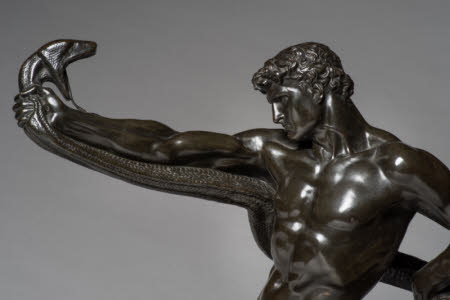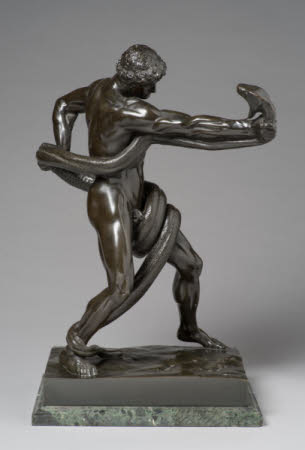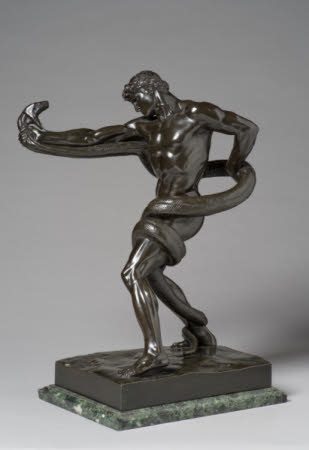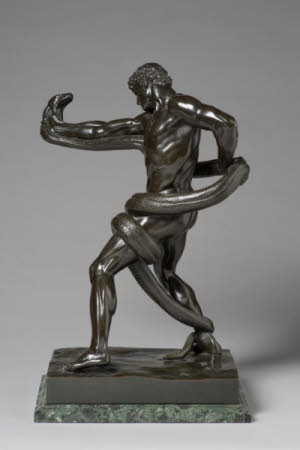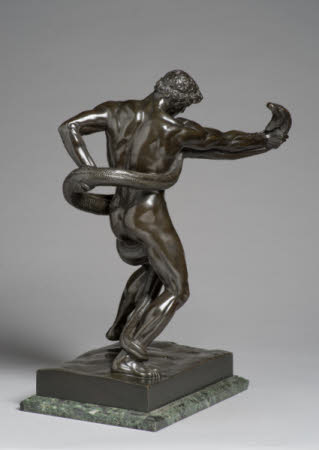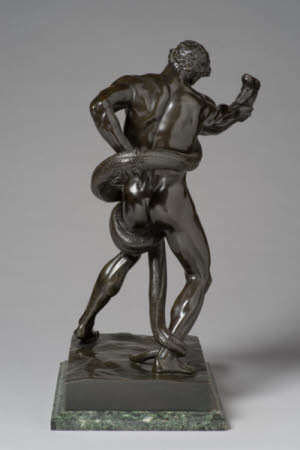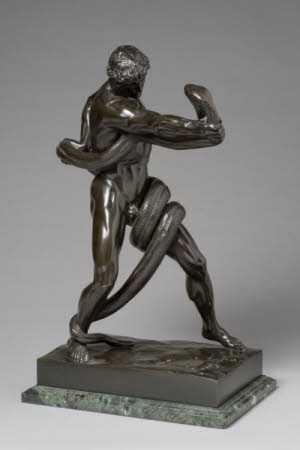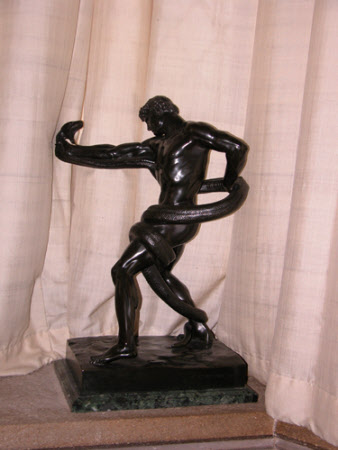Athlete wrestling with a python
Sir Frederic Leighton, Lord Leighton PRA (Scarborough 1830 – Kensington 1896)
Category
Art / Sculpture
Date
1877 (model) - 1905 (cast)
Materials
Bronze on bronze and marble base
Measurements
555 x 339 x 310 mm
Place of origin
United Kingdom
Order this imageCollection
Anglesey Abbey, Cambridgeshire
NT 515041
Summary
Bronze on bronze and green marble base, Athlete wrestling with a python, Frederick, Lord Leighton (1830-96), model first exhibited 1877, cast 1905, signed and dated on proper left long side of bronze terrasse with incised inscription 'F. LEIGHTON 1877/IV' and on back of bronze base 'PUBD BY ERNEST BROWN & PHILLIPS/ AT THE LEICESTER GALLERIES LEICESTER SQUARE LONDON.' Bronze statuette of a naked man struggling with a large python that has wrapped its coils around the man’s left thigh and right ankle. The athlete holds back the snake’s body with his left hand, whilst with his outstretched right hand he grasps the animal by its throat. The figures are mounted on a rectangular bronze terrasse, in turn mounted on a stepped green marble base.
Full description
Although Frederic Leighton produced very few sculptures when compared with his output of paintings, sculpture played an important role in his artistic philosophy. This was summed up by the critic A. L. Baldry when he wrote that ‘If an attempt were made to explain in a few words Leighton’s position in art, it would probably be most correct to say that he was, by instinct and habit of mind, more a sculptor than a painter. He looked at nature with a sculptor’s eye, and he adopted a kind of technical process which in its progressive building up was closely akin to modelling…. That he had a sculptor’s mind is proved by many of his studies in which he drew a figure, or group of figures, from three or four points of view, so as to arrive at what may be called the anatomy of the pose.’ (Alfred Lys Baldry, Leighton, London 1908, pp. 75-76). Leighton was interested in the possibilities of bronze from an early age. As a young man, in 1852, he had visited the Hofkapelle (Court Chapel) in Innsbruck, where he was much taken with the full-size figures in bronze on and around the tomb of the Emperor Maximilian I: ‘I gazed at them in a manner that I hardly ever felt before; their great merit consists in combining in the most astounding manner the most consummate knowledge of the art with all the simplicity of nature and the most striking individuality (that first of artistic qualities), and exhibiting at the same time the most elaborate finish in the details, with greatest possible breadth and grandeur of general masses…’ (Mrs Russell Harrington, The Life, Letters and Work of Frederic Leighton, London 1906, I, p. 69). Leighton produced three ideal sculptural figures for exhibition, the Athlete wrestling with a python, shown at the Royal Academy in 1877, The Sluggard (example at Anglesey Abbey, NT 515028) and Needless Alarms, both shown in 1886. The notion of creating the sculpture of the Athlete wrestling with a python came to Leighton whilst he was engaged on his major painting The Daphnephoria (Lady Lever Art Gallery, Port Sunlight) in the mid-1870s. He first made a small model, which was admired by his friend the sculptor Jules Dalou, who encouraged Leighton to work the concept up into a life-size sculpture. The full-size monumental bronze version was exhibited at the Royal Academy in 1877, where it was much acclaimed. It has long been regarded as a seminal work in the history of British sculpture, a radical departure from the established canons, and heralding the so-called New Sculpture: ‘Nothing though, up until then, could match Leighton’s Athlete, a blend of possibly archetypal background classical imagery (the Laocoön, with its writhing muscularity) transfused with the virile naturalism of clenched muscles, protruding veins, complete nudity (note the Art Journal’s coded comment: ‘full of such realistic detail as modern anatomical knowledge demands’). Not only that, the work was shown in its completed state in bronze, every touch, every electric detail substantially and truthfully rendered.’ (Benedict Read, ‘Leighton and Sculpture’ in Jones et al.1996, pp. 81-92, p. 84). The sculpture was a carefully modelled exercise in naturalistic depiction of the human form, the detail and subtlety of the modelling transferred to the surface of the bronze. The monumental bronze version exhibited in 1877 was shortly thereafter purchased by the Chantry Bequest and is today in the Tate collections. Leighton was persuaded to make another large version in marble, formerly in the Ny Carlsberg Glyptotek and now in a private collection. A plaster model is in the Victoria & Albert Museum (Diane Bilbey and Marjorie Trusted, British Sculpture 1470 to 2000. A Concise Catalogue of the Collection at the Victoria and Albert Museum, London 2002, pp. 321-22, no. 488). Another bronze version, signed with the signature and date but without the numbering, and without the Leicester Galleries address on the back, is in the Ashmolean Museum Oxford (Penny 1992, no. 532). The edition published by the Leicester Galleries came in two sizes, with at least some of the casts numbered – the Anglesey Abbey example is no. 4. The Leicester Galleries, the trading name for which was Ernest Brown and Phillips, operated from 1902 to 1975. From 1905 it began to offer casts of works of sculpture, the advertisements in its catalogues for sculptures by Leighton running until 1914 (Evelyn Silber, ‘The Leicester Galleries and the promotion of modernist sculpture in London, 1902-1975’, Sculpture Journal, 21.2 (2012), pp. 131-44, p. 135). The advertisement first appears in June 1905 (Catalogue of an Exhibition of Water-colours of Burma by R. Talbot Kelly, R.B.A., Leicester Galleries, June-July 1905), so it would seem likely that the first casts of the Athlete wrestling with a python will have been made shortly before then. Jeremy Warren, 2018
Provenance
Acquired by Urban Huttleston Rogers Broughton, 1st Lord Fairhaven (1896-1966) after 1940; bequeathed 1966 to the National Trust by Lord Fairhaven with the house and the rest of the contents.
Credit line
Anglesey Abbey, The Fairhaven Collection (The National Trust)
Marks and inscriptions
On bronze base, proper left side: LEIGHTON 1877/IV On back of the bronze base: PUBD BY ERNEST BROWN & PHILLIPS/ AT THE LEICESTER GALLERIES LEICESTER SQUARE LONDON.
Makers and roles
Sir Frederic Leighton, Lord Leighton PRA (Scarborough 1830 – Kensington 1896), sculptor
References
Christie, Manson & Woods 1971: The National Trust, Anglesey Abbey, Cambridge. Inventory: Furniture, Textiles, Porcelain, Bronzes, Sculpture and Garden Ornaments’, 1971, p. 135, Silver Strong Room Ormond 1975: Leonée and Richard Ormond, Lord Leighton, New Haven and London 1975, pp. 93-4, Pl. 132 Read 1982: Benedict Read, Victorian Sculpture, New Haven and London, 1982, pp. 289-91, fig. 352 Newall 1990: Christopher Newall, The Art of Lord Leighton, Oxford 1990, pp. 90-92, fig. 61 Penny 1992: Nicholas Penny, Catalogue of European Sculpture in the Ashmolean Museum, 1540 to the Present Day, 3 vols., Oxford 1992, vol. III, p. 113, no. 532 Jones 1996: Stephen Jones et al., Frederic Leighton. 1830-1896, exh.cat., venue: Royal Academy of Arts, London 1996, pp. 182-83, nos. 75-78 Getsy 2004: David J. Getsy, Body Doubles. Sculpture in Britain, 1877-1905, New Haven and London 2004, pp. 14-42
